Victorian Desalination Plant
The Victorian Desalination Plant[2] (also referred to as the Victorian Desalination Project or Wonthaggi desalination plant) is a water desalination plant in Dalyston, on the Bass Coast in southern Victoria, Australia. The project was announced by Premier Steve Bracks in June 2007,[3] at the height of the crippling millennium drought when Melbourne's water storage levels dropped to 28.4%, a drop of more than 20% from the previous year. Increased winter-spring rains after mid-2007 took water storage levels above 40%,[4] but it was not until 2011 that storages returned to pre-2006 levels.
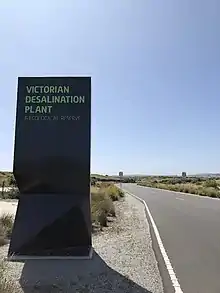 Entry on Lower Powlett Rd | |
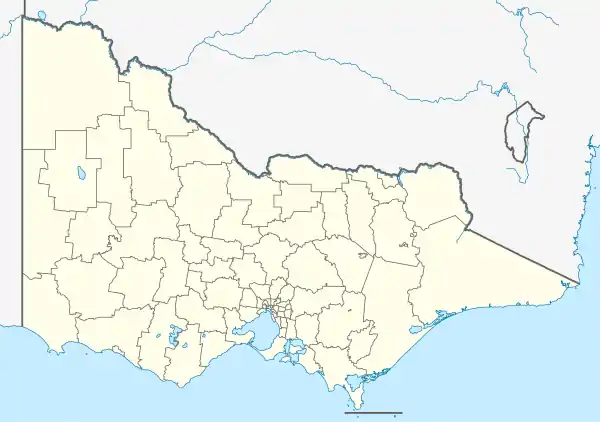 Location of Victorian Desalination Plant | |
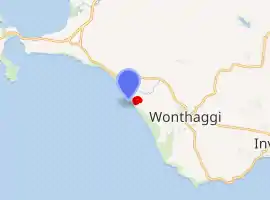
| |
| Desalination plant | |
|---|---|
| Location | Dalyston, Victoria |
| Coordinates | 38°35′16.8″S 145°31′33.6″E |
| Estimated output | 410 megalitres (14×106 cu ft) per day |
| Extended output | 550 megalitres (19×106 cu ft) per day |
| Cost | A$5.7 billion (max) contracted to 2039[1] |
| Energy generation offset | Windfarm at Glenthompson (proposed) |
| Technology | Reverse Osmosis |
| Percent of water supply | Estimated 33% of Melbourne |
| Operation date | December 2012 |
The plant was completed in December 2012, and was the largest addition to Melbourne's water system since the Thomson River Dam was completed in 1983. However, at the time, Melbourne's reservoirs were at 81% capacity, and the plant was immediately put into standby mode.[5] The first water released for public use was in March 2017 via Cardinia Reservoir.
As a rainfall-independent source of water the desalination plant complements Victoria's existing drainage basins, being a useful resource in times of drought. It is a controversial part of Victoria's water system, with ongoing costs of $608 million a year,[6] equivalent to .16% of Melbourne's FY2019 GDP,[7] even if no water is ordered. Construction commenced in mid-2009.[8] While the project will supply water for Melbourne, it is being managed by the Department of Sustainability & Environment (DSE) as a public-private partnership (PPP). DSE awarded the tender for design, build and operation to another company that will in turn supply the water to Melbourne Water, that makes payments to the plant owners and operators, Aquasure (Ventia/Suez). Melbourne Water pays the owner of the plant, even if no water is ordered, $608 million a year.[6] That is equivalent to .16% of Melbourne's FY2019 GDP,[7] or $1.8 million per day, for 27 years. The total payment is expected to be between $18 and $19 billion.[5] On 1 April each year, the Minister for Water places an order for the following financial year, up to 150 gigalitres a year, at an additional cost to Melbourne Water and consumers.[5]
Proposal
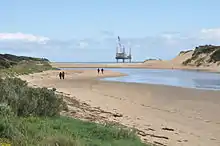
The potential for a desalination plant was promoted through the late 2000s in response to an increasingly severe drought which saw Melbourne's water storages go from 57.1% of capacity in January 2005 to 28.7% in June 2007.
The project was part of the Victorian Government's "Our Water, Our Future" water plan which included associated projects such as the North-South Pipeline, the Cardinia Pipeline and a proposed interconnector to Geelong.[9] The total average inflow into Melbourne dams from 1913 to 1996 was 615 gigalitres (2.17×1010 cu ft) per year, while average inflow 1997–2009, during Victoria's most severe recorded drought was 376 gigalitres (1.33×1010 cu ft) per year.[10]
The combination of drought and rapid population growth put pressure on reserve storage capacity which had dropped from 97.8 per cent in 1983 to just over one-quarter of maximum capacity in 2007.[11][12] As a result, water restrictions were in place for several years.[13]
The desalination plant and associated infrastructure includes tunnels connecting the plant to marine intake and discharge structures up to 1.2 km (1⁄2 mi) out to sea, an 85-kilometre (55 mi) pipeline to connect the plant to Melbourne's water supply system, and power supply infrastructure for the plant.
The plant can provide up to 150 gigalitres (5.3×109 cu ft) of additional water a year, with the potential to expand production to 200 gigalitres (7.1×109 cu ft) per year.[14]
A two-headed marine structure extends up to 2 km (1 mi) offshore was to be temporarily constructed. The plant takes in 480 billion litres (1.1×1011 imp gal; 1.3×1011 US gal) of seawater and pumps back 280 billion litres (6.2×1010 imp gal; 7.4×1010 US gal) of saline concentration every year.[15]
A six turbine windfarm was built in 2005 and is located at Glenthompson to offset the facility's electricity use.[16]
Estimated water production is 150 gigalitres (5.3×109 cu ft) of desalinated water per year, potentially providing around a third of Melbourne's annual water consumption (based on 2007 consumption levels). It is intended that the water produced will be supplied to Melbourne, Geelong, Western Port and South Gippsland.
The intake pipes for the desalination plant are located over 1 kilometre (1⁄2 mi) out to sea.[17]
Environmental effects studies
In August 2008, a 1,600-page environmental effects study report was prepared and found that; "...several protected species could be affected by the plant's construction and operation – including the orange-bellied parrot, the growling grass frog and the giant Gippsland earthworm – but none would be left "significantly" worse off.". The community was given 30 business days to respond to the report.[15] Watershed Victoria claimed that this was insufficient time for community groups to analyse the report and prepare submissions.
Contract to build and operate
There were eight tenderers for the contract for the construction and operation of the plant,[18] with two consortia being short-listed – AquaSure (Ventia Contractors/Suez) and BassWater (John Holland Group/Veolia Environmental).[19]
On 30 June 2009, the AquaSure consortium, which is made up of Degremont, Macquarie Capital and Ventia Contractors, was named the winning bidder.[16] Simultaneously, it was announced that construction was scheduled to commence in late 2009, proposing that water be delivered by late 2011.[20]
A$1.8 million per day fee is payable to the construction consortium. This minimum fee that is payable for 27 years after completion. Even if no water is required, the total payment is between $18 and $19 billion.[5]
Location

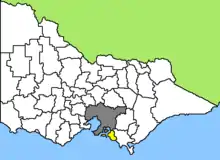
Nine sites were included in the feasibility study's "long list", and subsequently reduce to four (Surf Coast, East of Port Philip Bay, West of Western Port, and Bass Coast). The Bass Coast was chosen as the premium location.[14] Compulsory acquisition notices were issued to affected residents on 25 January 2008.[21]
The site is a 20-hectare (49-acre) area in Dalyston next to Williamsons Beach on the Bass Coast in south-eastern Victoria. It is between Wonthaggi and Kilcunda and near the Powlett River.
The site is located on Bunurong aboriginal land, specifically the Boakoolawal clan which lived in the area south of the Bass River before white settlement. Middens containing charcoal and shellfish mark the location of their campsites along the coast.[22] Many significant archaeological artifacts have previously been discovered around the construction site,[23] including Australia's first dinosaur bone, the Cape Paterson Claw, discovered nearby in 1903 by William Ferguson near what is now Eagles Nest, Bunurong Marine National Park in Inverloch.[24]
Plans are underway to build a much larger, wind farm at Glenthompson to offset the electricity used by the desalination plant.[16]
The site is located in the Powlett River Coal Fields where the State Coal Mine produced most of the steam-locomotive fuel that serviced the Victorian Railways network, from 1911 until 1978.[25]
Cost
The capital cost for the project was initially estimated to be $2.9 billion in the initial feasibility study; this was later revised to $3.1 billion[26] and then to $3.5 billion. After the winning bidder was announced it was revised to $4 billion.
Operating costs are to be charged by a private firm over a 25–30-year period and are estimated to be around $1.5 billion. This cost includes labour, replacement of membranes, chemicals costs and energy, and it was initially estimated at $132 million per annum.[27] Unlike previous water infrastructure works in Melbourne, the plant will be built and operated as a public-private partnership.
A 2008 report by the Water Services Association of Australia, modelling several national water-supply scenarios for 2030. It determined that sourcing water supply by seawater desalination was the most energy-intensive. The report predicted that if desalination was the primary source of supplying around 300 litres (66 imp gal; 79 US gal) per person per day, energy use would rise by 400% above today's levels.[28]
On 12 December 2009 The Age newspaper published details of considerable areas of land made cheaply available to the plant's developers without the value of that land being included in the project's official costs.[29]
The average water bill for residents living in Melbourne was estimated to rise by more than 60 per cent over the following five years, while the Essential Services Commission estimated it might rise up to 96 per cent.
Then Water Minister Tim Holding, stated that; "Melbourne residents need to help pay for major water infrastructure projects, such as the desalination plant and the Sugarloaf (North South) pipeline."[30]
By comparison, the Kwinana Desalination Plant in Perth, Western Australia, was completed in 2006 with approximately 30–50 per cent of the output of the Wonthaggi plant. It cost $387 million to build and did not include an 85 km (55 mi) pipeline and windfarm.
Energy consumption
The plant is estimated to require 90 MW of electricity to operate. Additional energy will be required to pump the desalinated water from Wonthaggi to Cardinia Reservoir in Melbourne.
A commitment was made to invest in renewable energy to offset the power the plant uses in an attempt to make it carbon neutral.
Opposition
The project encountered opposition from community groups and local residents, and the Australian Greens and the business fundamentals were challenged during feasibility studies and assessments of Melbourne's water supply needs.[31]
Regular public rallies were conducted on the site and in Melbourne.
The community group Your Water, Your Say was one of the first organised opposition group. It was sent bankrupt after it lost a legal case after the group pursued the Victorian Government over lack of reports and consultation. The case centred on initial water requirement figures, feasibility studies and environmental effects reports among other issues. More recently, a new opposition group Watershed Victoria, has continued the opposition campaign. The government pursued legal costs, which sent the group bankrupt.[32]
Public rallies and protests were held at the site near Wonthaggi and in Melbourne on Spring Street outside the State Parliament buildings during 2007, 2008 and 2009.[33]
At a July 2008 protest several people were removed from Crown land, but none were arrested.[34]
In June 2009, a petition including 3,000 signatories opposing the plant was presented to the Victorian Parliament.[35]
Your Water Your Say v Minister for the Environment, Heritage and the Arts
Your Water Your Say (YWYS) opposed the proposal, taking legal action against the Victorian State Government regarding non-disclosure of financial information and lack of environmental studies and reports.[36] As of July 2008 YWYS lost the action, and the Federal Court awarded costs to the State Government estimated to be up to $200,000, effectively rendering the community group broke.[32] YWYS was subsequently disbanded.
In its submission response to the Environmental Effects Statement, YWYS stated: "The Federal and State Governments are aware that YWYS is unlikely to be in a position to pay its significant legal costs and hence their apparent inability to make a decision on this front can only be interpreted as an attempt to further avoid community scrutiny of this project."[37]
Sharing of private information with private consortia
In December 2009, it was revealed that private information obtained by Victoria Police during surveillance efforts on individuals involved or corresponding with YWYS, Watershed Victoria and other community groups, had been made available to the private consortium building the desalination plant, Aquasure, via a memorandum between the State Government, Victoria Police and Aquasure.[38] Victoria Police responded by explaining that the information would be used to better "manage" future activities and potential "security threats".[38]
Public access
Booked tours are run and plans are underway for Aquasure to open to the public. The gates open daily for public access to the 225-hectare (560-acre) park and 8 kilometres (5 mi) of walking, horse riding and cycling tracks. The plant is located next to Williamsons Beach and the Wonthaggi Wind Farm, Wonthaggi.[39]
Timeline
2007
- 19 June – the Victorian Government announced its intention to develop a seawater reverse osmosis desalination plant on the coast near Wonthaggi. The plant is explained to be part of a water plan marketed as Our Water Our Future.[40]
- 28 December – the Minister for Planning for the Victorian Government determines that the project would require assessment under the Environment Effects Act 1978 and preparations for an Environment Effects Statement (EES) begin.
2008
- 25 January – Compulsory acquisition notices issued to the residents of the proposed site.
- 4 February – the Federal Government determines that the project will have to require approval under the Environment Protection and Biodiversity Conservation Act 1999 (EPBC Act).
- 21 February – 13 March – draft scoping requirements for the EES placed on public exhibition.
- 4 May – final scoping requirements for the EES issued.
- 13 June – Justice Heerey awards costs to the Federal and State Governments a result of the action – Your Water Your Say v Minister for the Environment, Heritage and the Arts & Anor; Federal Court Proceeding VID188/2008.
- 5 July – The plant is addressed during the Climate Emergency Rally at various locations in Melbourne.
- 100 m (330 ft) of coastline is landscaped to alter the flow of Powlett River.
- 20 August – 30 September – Environment Effects Statement (EES) released for public comment by the State Government, community given 5 weeks to submit responses to the 1,600-page report.
2009
- 11 January – Planning Minister, Justin Madden, approved a planning scheme amendment to allow for a pilot desalination plant to come into effect on 17 January.[41]
- 30 July – Winning bidder for construction announced.
- 6 October – Construction commenced.
2010
- 4 February – First sections of the new pipeline are laid
2012
- Production and related operations commenced at end of year
- "Zero water order" for financial year 2012–2013 and plant immediately put into standby mode[5]
2017
- 19 March – Victorian Government announces the first water from the Wonthaggi Desalination Plant was now flowing into Cardinia Reservoir.
2018–2019
- Owing to dry conditions, two consecutive orders were placed for 100 GL and 125 GL of water, expected to meet a quarter of Melbourne's water demand, placing upwards pressure on water prices.[42]
2035–2045
- Contract for the operation of the plant expected to expire.
Media
Construction of the plant was described in an episode of Build It Bigger, which aired on the Discovery Channel and the Science Channel in the United States in 2011.[43]
Photos
 Construction of pipeline to Melbourne from Wonthaggi desalination plant
Construction of pipeline to Melbourne from Wonthaggi desalination plant Construction of pipeline to Melbourne from Wonthaggi desalination plant
Construction of pipeline to Melbourne from Wonthaggi desalination plant Wonthaggi desalination plant construction in progress
Wonthaggi desalination plant construction in progress Little Powlett River and rig near Wonthaggi desalination plant
Little Powlett River and rig near Wonthaggi desalination plant Little Powlett River estuary near site of Wonthaggi desalination plant
Little Powlett River estuary near site of Wonthaggi desalination plant
References
- "Fact Sheet Project Costs" (PDF). Government of Victoria. March 2015.
- "The Victorian Desalination Project". Retrieved 28 October 2013.
- "Bracks announces $5 billion water plan". The Age. 20 June 2007.
- "Melbourne Water water storage graph 1997–2010". Archived from the original on 7 September 2010. Retrieved 5 September 2010.
- "Victorians pay dearly, but not a drop to drink". ABC News. 18 December 2012. Retrieved 2 January 2013.
- "Subscribe to the Herald Sun". Herald Sun. Retrieved 15 September 2016.
- "Melbourne closes on Sydney as nation's economic powerhouse". The Sydney Morning Herald. Retrieved 7 January 2020.
- Our Water, Our Future – Desalination Plant Archived 2007-11-08 at the Wayback Machine
- "The Next Stage of the Government's Plan". Melbourne Water. 16 June 2009. Archived from the original on 3 July 2009. Retrieved 4 July 2009.
- Melbourne Water, Annual inflow chart
- "Answers to your questions on storage levels". Melbourne Water. Archived from the original on 1 July 2009. Retrieved 4 July 2009.
- "Government Programs & Action – Background". Melbourne Water. Archived from the original on 4 July 2009. Retrieved 4 July 2009.
- "Melbourne water storage levels continue to drop". ABC News. 10 March 2009. Retrieved 4 July 2009.
- "Seawater Desalination Plant Feasibility Study – Executive Summary" (PDF). Melbourne Water. June 2007.
- The Age, 21 August 2008.
- "Desal consortium selected". ABC News. 30 July 2009.
- Victorian Desalination Plant, retrieved 4 November 2013
- Davidson, Kenneth (25 June 2009). "Water policy delivers scary possibilities". The Age. Melbourne, Australia. p. 17.
- "Facts Sheet" (PDF). Melbourne Water. June 2007.
- "Compulsory acquisition notices" (PDF). Your water, your say. 25 January 2008.
- Bass Coast Information Centres, retrieved 13 November 2013
- Parks Victoria, retrieved 14 November 2013
- The Museum of Victoria, retrieved 14 November 2013
- Heritage Victoria, retrieved 16 November 2013
- "Our Water Our Future – The Next Stage of the Government's Water Plan, Desalination Plant to Deliver 150 billion litres (3.3×1010 imp gal; 4.0×1010 US gal) of Water Per Year". Victorian water Industry association. Retrieved 4 July 2009.
- "Seawater Desalination Plant Feasibility Study – Chapter 9a" (PDF). Melbourne Water. June 2007.
- The Age, 30 August 2008, "Water plant to guzzle energy", Peter Ker
- Ker, Peter (12 December 2009). "True cost of desal plant concealed". The Age. Melbourne, Australia.
- ABC, "Water bills set to rise", Fri 7 November 2008 11:52am AEDT.
- The Age, 25 September 2008, "Water policy is based on flawed figures", Kenneth Davidson
- Ross, Norrie (13 June 2008). "Opponents of Victorian desalination plant must pay costs". Herald Sun. news.com.au. Retrieved 19 July 2008.
- "Desal opponents resume protest at Wonthaggi". ABC News. Australian Broadcasting Corporation. 14 July 2008. Retrieved 19 July 2008.
- "Protesters met by police at desal site in Wonthaggi". Herald Sun. news.com.au. 14 July 2008. Archived from the original on 3 August 2008. Retrieved 19 July 2008.
- "Vic Parliament receives Wonthaggi desal petition". ABC News. 11 June 2009. Retrieved 4 July 2009.
- "Action group loses legal challenge over desalination". ABC News. Australian Broadcasting Corporation. 16 May 2008. Retrieved 19 July 2008.
- "YWYS EES Submission". 30 September 2008.
- The Age, Front Page, Saturday 5 December 2009.
- Wonthaggi Wind Farm, Clean Energy Council, retrieved 28 October 2013
- "Our Water Our Future". Archived from the original on 19 May 2009. Retrieved 14 March 2009.
- Bass Shire Council, 15 January 2009
- Carey, Adam (13 August 2018). "Proposed record desal order to put pressure on water bills". The Age. Retrieved 29 June 2019.
- "Australian Desalination Plant". The Science Channel. Retrieved 7 April 2012.